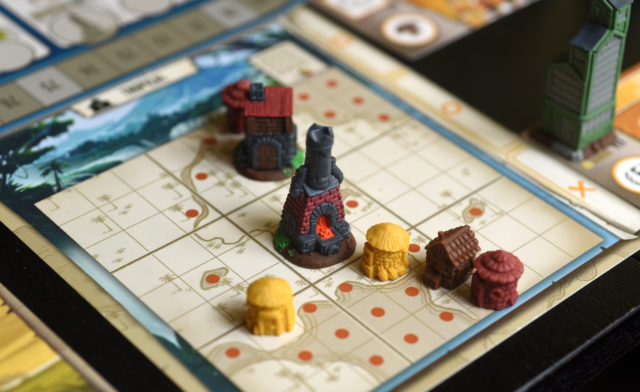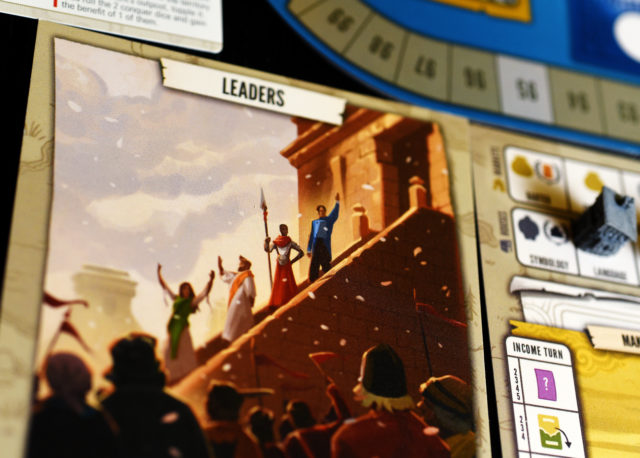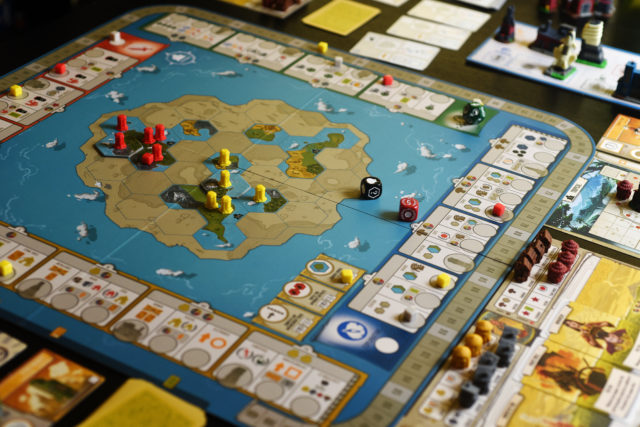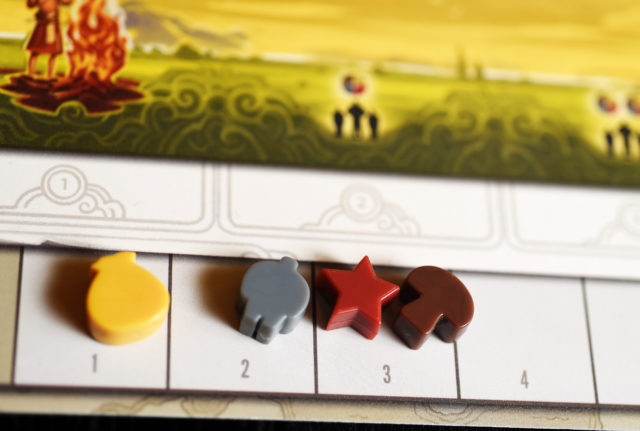The phenomenon that was/is Wingspan was still cresting in early August when Jamey Stegmaier announced that the game with code name “Clay” was going to start taking pre-orders in early September and shipping in October. Tapestry was a civ game that could be played in 90-120 minutes by 1-4 players; the game would include the by-now-expected Automa bot.
Frenzy ensued.
In the extensive designer diary he posted over the following weeks, Stegmaier laid out his vision for the game and how it came to fruition. In discussing his inspiration for Tapestry he name-checked many of the civ games I looked at in my three-part examination of the genre (you can read them here, here, and here): Through the Ages, Nations, The Golden Ages, and so on. He also dipped his toe into the videogame franchise which arguably spawned most of these games.

I’ve played pretty well every tabletop civ game out there, and Stegmaier’s announcement ignited my hopes that finally, someone would hit that sweet spot where the epic sweep of history, the “just one more turn” vibe, and a two-hour playtime all met. And if anyone could pull it off, I reasoned, it would be Stegmaier. His previous games Viticulture and especially Scythe to me epitomize the best of modern game design, with a seamless interlocking of mechanisms which mesh with theme and provide a constant stream of interesting decisions. Add to this the proven track record of the Automa, and Tapestry was an insta-buy for me…
…that is, until I read that the game would not be set on a historical Earth but some parallel world. Wanting to avoid treading on delicate historical sensitivities is understandable (I mean, do we need another thread about who was worse: Hitler, Stalin, or Mao?) but for me part of the fun is pretending to be at the helm of actual, historical civilizations.

Then there was the price: over $100 Canadian. Any why? So we could have pre-painted Smurf-like buildings? I mean, they looked cute and all, but why not offer them as an upgrade? Alas, the decision was made to have just a single version for everyone, which again I understood from an economic standpoint, but still…
Could I even expect the game to arrive in good time? Starting with Scythe, Stonemaier Games had become notorious for underestimating the demand for its games, resulting in months-long wait times for pre-orders to be fulfilled. This came to a head with Wingspan; between front-page coverage in the New York Times and winning the Spiel des Jahres, interest in the game was at a fever pitch, but copies were almost impossible to find, and some people capitalized on this by flipping their copies for ridiculous amounts.
Some even accused Stonemaier Games of purposefully creating a scarcity-driven hype machine by deliberately underestimating demand. I find this kind of armchair-publishing amusing if it weren’t so hurtful. Really? You would have gone all-in on a game about birds? By a first-time designer? I wish you luck in your future endeavours.

In any case, we can never know what would have happened if Stonemaier had gone the other way and saturated the Wingspan market. I did hope Stonemaier learned from the experience in calculating the initial run of Tapestry. As it turns out, the early fulfilment of pre-orders (to Canada at least) was not reassuring: by some error, only 20% of the first batch were sent on time, the remainder trickling in right before the promised deadline of September 30.
Before their copies had even arrived, some locals had already decided to sell theirs off after the initial reviews from the US. They were not exactly the gush that had met Scythe or Wingspan. Some thought the game wasn’t civ enough. Some had issues with play balance. And some were just frustrated by elements of the production and design.
My own feeling is that Tapestry absolutely delivers on its promises: it is at least as good as my other favorites (Civilization: a New Dawn, Historia, and The Golden Ages–and if you didn’t like any of those you probably won’t like Tapestry either). It’s got huge replayability, it’s not hard to teach, it’s easy to get into, and its strategic depth reveals itself with repeated playings. Plus the Automa mode is really easy to implement and provide a fine simulacrum of true multiplayer.
So let’s take the criticisms one by one and look at the game more closely.

Is Tapestry a true civ game, or is it just an engine builder with a thin veneer of civviness? It definitely fits my own criteria, having both a map and a tech tree, in the form of the Advancement tracks. They could have used cards for Advancements, which would have maybe made it feel like you actually got something tangible (as in, say, Through the Ages) but tracks accomplish the same thing more cheaply and also make it easier to see the game state more clearly in terms of who’s ahead of whom. And from a gameplay standpoint, I like the system because if you know what you’re doing, the Advancement tracks and Tech cards can be used to fashioned some pretty devastating combos.
Still, the Tech cards are a bit of a red herring in terms discussing how the game deals with technology. While some have mocked the game for allowing societies to “discover” Lithium Batteries while still at the archery level, I personally find it refreshing compared to many other civ games (analog or digital) which force you to discover things in relative lock-step across the board with their prerequisites, so all civs at the end of the game are pretty much identical.

Yet many people looked at the Advancement Tracks and saw a race game, assuming that the player who got furthest on all four tracks must be the winner. Most of these people could not possibly have played the game because it had hardly been released. I can tell you from my plays that the winning player usually topped out on one track (after all, being the first to do so gets you a solid VP bonus) and I definitely agree that concentrating on one or at most two tracks is the way to go, there is no one track which dominates the others.
When it comes to play balance, the two biggest complaints have been about the variance in Tapestry cards and civ powers. Their power varies depending on the player count and when you draw them (you can acquire additional civs in the late game if you invent Radio among other methods).
It’s easy to discount Tapestry cards at first. And since you usually only ever play three of them, it doesn’t seem worth it to take them when you get the chance. Yet they are also highly swing-y, some being much more valuable earlier on, some more chance-dependent, and some just strictly better than others. They seem to add a lot of unnecessary luck to the game.
But the game is called Tapestry. It should dawn on you at some point that these cards are more important than they first appear. Maybe you should get as many as possible so you have the widest possible choice when it comes to playing one. Which is what I now tell people right off the bat when I teach the game, and it has made a big difference in terms of first impressions.
In a similar vein, there is no question that some of the civs are easier to play than others. I remove the Futurists, Inventors, and Mystics from the civs I give out: the first two because they require more effort from the other players to keep in check and the last because it requires you to predict how well you will do in four different ways, which is almost impossible to carry off well as a first-time player.

There is someone on BGG who is compiling a database of civ victories and there seems to be no question that, like say Terra Mystica, there is significant enough variation in win rates to require some kind of VP handicap down the line. That doesn’t stop Terra Mystica from sitting in BGG’s top 20. (Of course the game is seven years old.) While it rankles me to see yet another example of a publisher using consumers as after-the-fact playtesters, I do love the variation in the different Tapestry civs and how they can alter playing-styles and decision-making.
As an aside, according to that database if you’re looking for a well-balanced quartet of civs for a first game it looks like Historians/Leaders/Nomads/Isolationists is the way to go. I would also highly recommend this video by Rodney Smith of Watch It Played where he talks about perceptions of play (unbalance), specifically referencing Tapestry.
Finally we come to production design choices. One of the space exploration tiles has a misprint–which is easily remedied with a felt-tip marker and yes I know how heretical that sounds to some people, but seriously get a grip.
Other than that all the components are high-quality: the rules and playmats are made out of resin-coated paper that feels luxurious to the touch; the dice are etched instead of screen-printed; and of course you have the buildings. I’ve made my peace with the buildings. They’re a little goofy-looking and for all the effect they have on gameplay they could have been tiles, but the mechanic of placing them in your capital to fill districts and complete rows and columns is engaging to me. It gives the merest hint of city-management, which of course is a huge part of the Sid Meier computer game. Remembering which building is which is a pain since they’re not labelled, and knowing which goes in which part of the insert is a puzzle in itself until you realize there’s a diagram of the insert on one of the box sides–mentioned nowhere, by the way.
It’s also very confusing and annoying at first that the buildings sit on naturalistic bases instead of square-based ones, which can lead to some bad decision-making when you realize that the building you’ve been working towards actually doesn’t fit in the gap you’ve left for it. Furthermore, the bases could have easily been colour-coded so players would know which buildings belong to which Advancement Track.
Then there are the rules and play aids themselves. The main game and solo game rules are four pages each–a tribute to the elegance and simplicity of the underlying game structure. In striving to be concise, however, some edge cases (mainly around the final advance on the Technology Track, “A.I. Singularity”) are never addressed. Make sure to check BGG. The Automa Rules have even more gaps which they expect you to fill in yourself–which is possible, once you have digested all the rules, but until then requires some unnecessary flipping back and forth. And the player aid cards are more problematic. The main one, with the action descriptions, is downright misleading, making it seem as if you’re taking the “primary action” of each track every time you advance, instead of only when you see the one particular icon.
These production issues will of course be remedied in future print runs. None of them are game-breaking and none of them spoil the game for me, but ymmv.
In the end the three main knocks against Tapestry are all valid, and considering the sticker price you’d be perfectly right to pass on it, especially if you’ve already got a civ game you like in your library. If it had a pricetag of $60 I think people would be salivating over it. I’ve played it half a dozen times in the three weeks since getting it and am still not bored of it, which for me is a big deal.
Given that the Wingspan expansion was just announced I don’t know what the rush was to bring Tapestry to market in the first place was. It would definitely have benefitted from being kept “in the oven” longer before release. Of course, that applies to many if not most games today, analog and digital. Try it before you buy it, but try it.
Enjoyed this review. The buildings are my biggest complaint just because it seems an unnecessary expense, but you’re right to say it makes the city management feel more authentic.
My wife and I get a kick out of the game and the imbalance is more interesting than frustrating. One of us got the futurists and just destroyed the other. Finding the antidote was more important than forbidding that civilization.
It passes the test for me of being fun even when I’m losing, and I want to play again when I finish a game.
I own a lot of Stonemaier games, Scythe being my favorite, but Tapestry is right up there. I’m consistently impressed at the publishers ability to churn out top-tier games. Wingspan was beautiful and elegant, but Tapestry feels more like a return to form of epic board gaming.